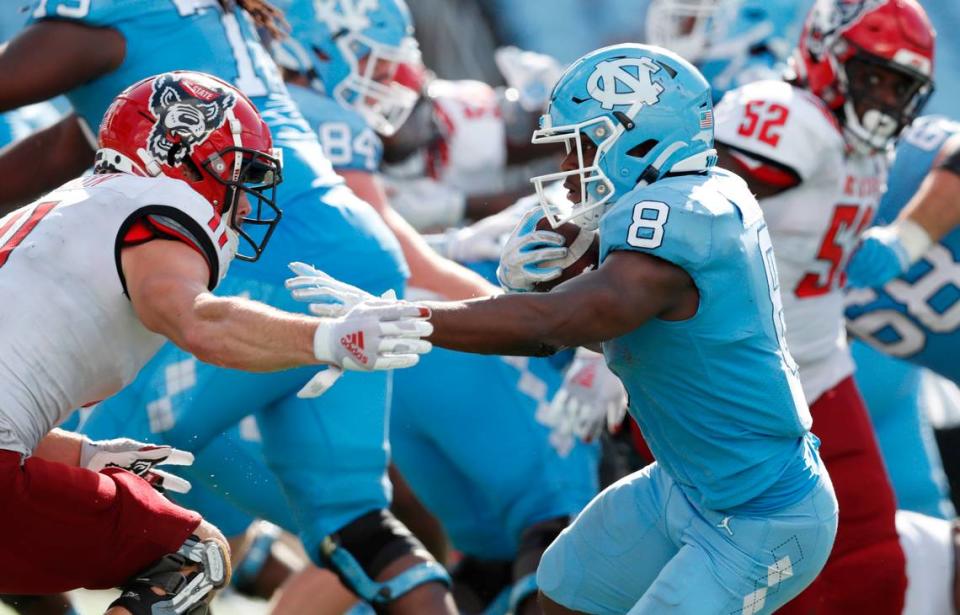College football rivalries like UNC-NC State are endangered as NCAA landscape shifts
- Oops!Something went wrong.Please try again later.
Though the stakes are not quite what they could’ve been, there’s still no shortage of significance to the North Carolina-N.C. State football game on Saturday at Kenan Stadium. The Wolfpack is playing, in large part, to salvage what’s left of its season. State, too, can spoil the Tar Heels’ pursuit of the rare feat (rare for these programs, that is) of 10 regular-season victories.
UNC, which has already secured its place in the ACC Championship Game next week, is playing to bolster its chance for an Orange Bowl bid, and to strengthen Drake Maye’s case to become a finalist for the Heisman Trophy, which would come with a trip next month to New York City. There’s all the usual intangibles at play, the bragging rights and what it means for supporters of both schools.
N.C. State and UNC are playing for the 112th time. It’s the one regular season game that both groups of fans, whether they want to admit it or not, most want their teams to win. It’s perhaps the most important college football game in this state; a divider of households, an annual measuring stick of both programs, a fitting finale to the regular season.
To people here, in this state, this is a game that matters. From Murphy to Manteo, there will be interest. It means something. North Carolinians, then, should enjoy it while it lasts, for in today’s college athletics world, the State-Carolina rivalry — and other regional rivalries like it — are becoming more and more endangered. The Tar Heels and Wolfpack have played each other for more than 100 years, but who knows how much longer the series might endure.

A changing college sports reality
The reasons for doubt, which might have sounded ludicrous not all that long ago, now feel real: What if the conference to which both schools belong, the ACC, can’t maintain its place in a time when football television revenue drives all? What if UNC, facing the reality of a diminished ACC, were to one day accept an offer to join the Big Ten or SEC? What if State and Carolina, about 30 minutes apart, find themselves in different conferences before too long?
The ACC seems secure, for now. At least more secure than it did in the days following the revelation, last summer, that UCLA and USC were leaving the Pac-12 for the Big Ten. That news set off something of a panic. It underscored what Notre Dame athletic director Jack Swarbrick told a group of reporters just a couple of months earlier, during the ACC’s annual spring meetings. Swarbrick then was speaking broadly of a consolidation of power in college athletics when he said:
“We’re getting to a two solar system model here. You’ve got two suns with all the gravitational pull, the Big 10 and the SEC, and people are going to have to figure out how to align with one or the other.”
UCLA and USC made their choice. Texas and Oklahoma, who are leaving the Big 12 for the SEC, made theirs the summer before. The ACC has been the beneficiary — it seemed so at the time — of other similar moves during its two major rounds of expansion over the past 20 years. Those moves, particularly the additions of Miami and Virginia Tech in an effort to strengthen football, and Syracuse in an attempt to bolster basketball, were supposed to solidify the ACC for the long haul.
And, well, here we are, instead, with the conference continuing to fall farther and farther behind the Big Ten and the SEC in television rights revenue, which pretty much drives everything. It’s not the ACC’s fault, necessarily. At one time, it was the most powerful league in the country. Its basketball television deal in the 1990s and even through the early 2000s was the most valuable commodity in college athletics, even more so than SEC football. It’s why Florida State wanted in in the early 90s.
But things change. Just as football television money entered a different stratosphere, starting around the mid-2000s or so, the ACC’s biggest football brands floundered. Miami, since joining the conference, has never been close to what it was in the 1980s or 90s. Virginia Tech has fallen off. Florida State, while in the midst of a strong season, isn’t the force it was for the better part of two decades. Couple that with the reality that the ACC has its share of relatively smaller schools, with smaller fan bases, and the league’s financial plight becomes more understandable.
That the ACC hasn’t been pillaged, already, is a testament to the strength of the grant of rights agreement holding its members together. Schools can thank, or curse, former commissioner John Swofford for that. After Maryland defected for the Big Ten — and this week marked the 10th anniversary of the news Maryland was leaving the ACC — Swofford and the ACC’s presidents and chancellors enacted the grant of rights, which makes it all but financially impossible to leave.
The agreement runs through 2036, same as the league’s contract with ESPN and, so far, the grant of rights has held strong. But can it last another 14 years? And what will college athletics even look like then? Barring an act of benevolence on behalf of ESPN, which is the ACC’s primary financial partner, the league will continue to fall behind its two conference rivals. The gap is hundreds of millions of dollars wide now, and that’s before the Big Ten and SEC’s new TV deals that go into effect in the coming years.

A rivalry on the ropes?
Which brings us back to the State-Carolina game Friday. On the field, for better or worse, these are programs that have mostly been evenly matched since the creation of the ACC in 1953. For both, beating each other has often been the highlight of a season — probably too often, given that neither has won the ACC in more than 40 years.
Off the field, though, UNC is clearly in a different place in a changing landscape. Carolina would have attractive options if the ACC were to fall apart, be it landing in either the Big Ten or SEC. N.C. State’s best hope, meanwhile, is probably for the ACC to find a way to remain intact. Last summer, the day the Big Ten news broke, UNC Chancellor Kevin Guskiewicz texted with Bubba Cunningham, the school’s athletic director, about the forces shaping college athletics.
They went back and forth, according to records UNC released to The News & Observer, about having a plan and being prepared. At one point Guskiewicz asked Cunningham whether he’d talked with Boo Corrigan, the N.C. State athletic director.
“I’m curious where they stand,” Guskiewicz wrote.
“I have talked to Boo a couple of times but they really don’t have a position,” Cunningham responded. “They obviously would prefer more money but not sure which league would take them.”
That’s what college athletics has become in 2022. As much as what happens on the field matters, a school’s brand name — and how it might translate into television ratings and eyeballs for ad-buyers — matters much more. That reality in recent years has brought an end, or at least an extended hiatus, to no shortage of rivalries. Games that mattered, some of them with more than 100 years of history, have disappeared as conferences have fallen apart and schools have gone their own ways.
Oklahoma-Oklahoma State will soon join the club, when the Sooners depart for the SEC in 2025. Their football rivalry, known as Bedlam, will not continue, athletic directors from both schools have said. The reasoning is clear enough: “It is one of the consequences of OU’s decision (to join the SEC),” Chad Weiberg told The Action Network in September. “It’s disappointing for the people of the state of Oklahoma.”
For now, the people of North Carolina have State-Carolina in football. It’s not exactly Bedlam, but there is more than a century’s worth of history, and plenty of moments that have endured. It’s the one college football game in this state that carries some mystique. It doesn’t register all that much nationally, but it matters here. It’s part of what makes college sports special in North Carolina, but now there are no guarantees. Who knows if it will endure.
Enjoy it while it lasts.
